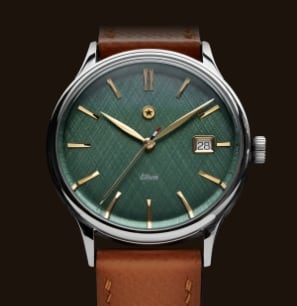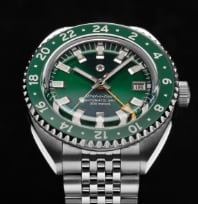Long before the traditional chronograph watches were invented, people could tell the time by watching the sun cast a shadow across a sundial. Centuries later, after generations of innovation in watchmaking, we’ve come full circle. Thanks to modern advances in timepiece technology, people are once again using the sun to tell the time—but with something a bit more contemporary than the sundial.
We’re referring, of course, to the solar watch.
Solar watches are among the newest and most advanced timepieces in existence, and it’s no wonder that watch collectors and enthusiasts are such big fans of these incredible devices. If you don’t know much about solar watches or have never even heard of them, don’t worry—we’re here to tell you all about them and why you should add one to your collection.
Different Movements
Before we get into the specifics of the solar watch, it’s important to understand the basic mechanics of watches—namely, what makes them tick. Up until the invention of the solar watch, there were three different mechanisms (called movements) that made watches different from a standard bracelet and overall, how they work: mechanical, automatic, and quartz.
Mechanical
Mechanical watches, as their name suggests, are watches that work purely mechanically. A mechanical watch derives its power from a device called a mainspring, which is a tightly wound strip of metal that releases tension at tiny, measured increments—as tension is released from the mainspring, power flows through the various components, like the dials, of the watch.
The problem with a mainspring is that it eventually will run out of power, so watches that rely on mainsprings must be regularly wound in order to keep running. That’s easy enough, but if you have multiple mechanical watches for different occasions, it can be annoying and time-consuming to have to wind a watch and set the time every time you take it off the shelf.
Automatic
Built with many of the same mechanics and components of mechanical watches, automatic watches also rely on a mainspring in order to function. The major difference between mechanical and automatic watches, however, is that automatic watches wind themselves—kind of.
While a mechanical watch needs a human—or a special watch winder—to twist its crown (the knob that’s used to wind the watch), automatic watches are built with a weighted rotor. As the automatic watch’s wearer swings their arms, the rotor turns inside the watch, constantly winding the mainspring.
Although this is an amazing feature, automatic watches’ self-winding mechanism comes with a caveat: if you don’t wear the watch, the rotor won’t wind it, and it’ll run out of power. You’ll have to wind it by hand in order to get it running again.
Quartz
For those who don’t ever want to wind a watch, quartz movements offer a simple and modern alternative to the mainspring: a battery.
Built with internal batteries, quartz watches never need to be wound—they keep running as long as their batteries have power. Of course, as everybody with a remote control knows, all batteries eventually need to be replaced. If your quartz watch has a lot of special features, they might run down its battery fairly quickly—and constantly replacing watch batteries can get expensive.
In 1969, the watch manufacturers at Seiko invented the Japanese Quartz movement.
Solar
This brings us to solar watches—watches built around newer movements that harness the power of the sun (or strong artificial light). Instead of relying solely on batteries, solar watches absorb light and convert it into energy that keeps the watch running through solar power.
There are many benefits to this type of movement, and we’re going to get into all of them up ahead.
Why Solar?
There are many reasons why watch enthusiasts are crazy about solar watches these days. Not only does their ability to harness the power of light make them effortlessly perfect for even the most fast-paced lifestyles, but they also are incredibly well-designed in every other aspect.
Light Is Everywhere
The name “solar” might be something of a red herring, as solar watches don’t specifically require sunlight in order to work—any light source will do. So even if you never see the light of day, as long as there are some light sources (even artificial ones), your solar watch will continue to power itself.
Special Features Often Come Standard
Because solar watches don’t rely on the power of a mainspring in order to keep running, it’s possible to add plenty of additional features to solar watches that would otherwise drain less advanced watches. You might see similar features in some mechanical watches, but these features will use up more of the mainspring’s power, which means you’ll have to wind it more frequently. But with a solar watch, you don’t need to worry about that—you can just enjoy their special features.
Compass
We can’t always rely on our smartphones to get us from point A to point B, especially if we find ourselves in a location without cell service. If you’re an avid outdoors person, you need to have a digital compass with you to aid in navigation—with a solar watch equipped with a compass, you already have one right on your wrist.
Barometer
Even if you’re constantly checking the weather, you can never fully trust the accuracy of a weather forecast. That’s why many solar watches come equipped with a barometer that helps measure barometric pressure—so you can act as your own weatherperson simply by looking at your watch. Who needs a thermometer when you have a barometer?
Durability And Water Resistance
Solar watches are often made from very durable materials, such as titanium or stainless steel for their cases and hardened crystal or sapphire for their
Watches that are water-resistant are incredibly useful—both for those who forget they’re wearing their watch when they hop into the shower, and those who need to keep an eye on the time when they’re underwater.
Because you don’t need to access the battery of a solar watch very often, and there’s no need to wind it, solar watches experience limited wear and tear of their external parts. The rubber gaskets that maintain a watch’s water resistance can wear down over time after many windings and battery replacements—but with a solar watch, those gaskets can keep working for longer.
Longevity
Even though solar watches rely on light in order to keep running, they still have very long battery life. Many solar watches can last without sun for over a week or even up to six months—so whether you’re working in a coal mine or living through an Alaskan winter with one sunrise, your solar watch will keep on ticking.
Accuracy
Telling time accurately is arguably the most important aspect of a watch, and solar watches accomplish that task amazingly well—they’re among the most accurate watches on the market, outperforming most watches with mechanical, automatic, and quartz movements.
Environmental Friendliness
While fossil fuels like oil and coal are the cause of major air pollution and greenhouse gas emissions, batteries have their own negative impact on the environment. They’re a much cleaner energy source than fossil fuels, but they still come with problems—the production, transportation, and distribution of batteries consumes plenty of natural resources and contributes to greenhouse gas emissions. Not only that, but when you dispose of batteries, they can end up polluting the water that we drink and that animals live in. For these reasons, rechargeable batteries are much better for the environment than disposable ones.
Because solar watches don’t need their batteries replaced nearly as much as quartz watches, the negative environmental impact of a solar watch is much smaller than that of its quartz counterparts. So if you’re looking for an eco-friendly watch option, the solar watch may be the perfect choice for you.
Affordability
To hear about all the incredible features of solar watches, you might find yourself thinking that they must be obscenely expensive luxury pieces—but they’re not. While some solar watches can run as high as $1,500, you can also find them for much more affordable prices.
Jack Mason’s Solar Watch
At Jack Mason, we’re proud to offer a highly fashionable, functional, and affordable solar watch with an analog face. Built with a recycled stainless steel case and a sapphire crystal, our solar watch is incredibly durable. Good for casual divers, it’s also water-resistant up to 100 meters and comes equipped with bright and easily readable SuperLuminova® markings, making it a handy tool for underwater use. The strap is made from recycled plastic, and the clasp is handy velcro. It comes with a deadly accurate second hand and compass on the bezel. The calendar will help you keep track of world times. Our solar watch is a smart, stylish option for any watch enthusiast to add to their collection.
In Conclusion
Solar watches may be one of the newest types of watch on the market, but they’re still a classic-looking option for those looking for a stylish, durable, long-lasting watch that comes with the added benefit of being one of the most eco-friendly options in the watchmaking world.
As we continue to forge new frontiers into how we tell time, it’s also important to think about the impact that we have on the world in which we live. Solar watches draw on the natural power of the sun and use few resources compared to other watches. While solar watches may look timeless and classic, they’re highly modern timepieces that are perfect for our rapidly changing world.
Sources:
Sundial | Definition, History, Types, & Facts | Britannica










